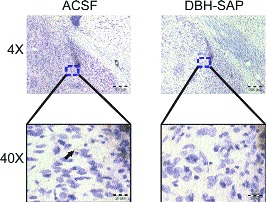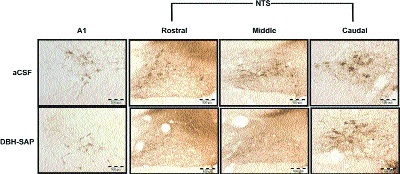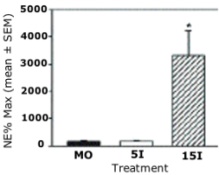Contributed by Lesley E. Northrop, Nicole Cameron and Mary Erskine, Department of Biology, Boston University
The posterodorsal medial amygdala (MePD) is involved in processing the information from genito- sensory stimuli which is needed for mating-induced pseudopregnancy. The amygdala complex is known to be involved in memory storage and consolidation, processes known to be influenced by amygdalar norepinephrine (1). In addition, previous research has shown the MePD and the A2 noradrenergic cell group show increases in c-fos expression after mating, indicating that cellular activation has occurred in these areas. It is not clear whether there are noradrenergic projections from the A2 nuclei into the MePD.
In the first experiment, we infused anti-dopamine-ß-hydroxylase-saporin (anti-DBH-SAP), a ribosome-inactivating neurotoxin which selectively destroys noradrenergic neurons, into the MePD to determine the source of norepinephrine in the MePD. A second experiment examined whether norepinephrine is released in the MePD during and after mating using a microdialysis technique.
Experiment 1: Ovariectomized female rats were infused with 20 ng anti-DBH-SAP in 0.2 μl of aCSF into the left MePD (relative to bregma; AP-2.7 mm, ML 3.5 mm, DV -6.7 mm from dura) according to the atlas of Paxinos and Watson (2). Eight days after infusion, animals were perfused and 30 μm sections through the brainstem were stained immunocytochemically using a DBH antibody. The forebrains were sliced and sections were stained with cresyl violet for injection site verification.
Figure 1 shows the location of the injection sites within the MePD at 4X magnification, and the lack of tissue damage around the site of injection at 40X magnification. There was no indication that local infusion of anti-DBH-SAP induced neurotoxic damage around the area of infusion, as similar numbers of neurons were present in anti-DBH-SAP and aCSF groups and since there did not appear to be microglial infiltration around the injection site in either group. Figure 2 shows the effects of anti-DBH-SAP on the number of DBH-stained cells within the A1 and A2 (nucleus tractus solitarius, NTS) cell groups. Significant reductions in DBH-positive cells were observed compared to aCSF controls. Quantification of the results are shown in Figure 3, where it can be seen that decreases in DBH-positive neurons occurred in the A1 and rostral and middle NTS. These data demonstrated that noradrenergic projections to the MePD originate within the latter two cell groups.
Experiment 2: Ovariectomized female rats were implanted with an intracerebral guide cannula targeting the left MePD, and were treated with estrogen and progesterone to induce sexual receptivity. Fourteen to sixteen hours before mating (36-38 h after injection with estradiole benzoate) a microdialysis probe was inserted through the guide cannula. Microdialysate was collected at 20 min intervals (20 μl/sample) beginning 2 h before to 3 h after mating. Animals received 5 intromissions (5I), 15I or 15 mounts-without-intromission (MO) during mating. The content of monoamines in the dialysis sample was analyzed by HPLC with electrochemical detection. As seen in Figure 4, there was a significant release of norepinephrine (max %) in females who received 15I, a number sufficient to induce the neuroendocrine changes of pseudopregnancy, whereas insufficient mating stimulation (MO and 5I) induced no increase in norepinephrine after or during mating.
These data show that noradrenergic cells within the A1 and A2 cell groups of the brainstem project to the MePD, and suggest that norepinephrine release in response to mating stimulation may be involved in establishment of the neuroendocrine memory of pseudopregnancy.



Figure 3. Decrease in DBH-positive neurons after treatment with anti-DBH-SAP.

References: (back to top)
- Peinado-Manzano MAAmygdala, hippocampus and associative memory in rats. (1994) Behav Brain Res 61:175- 190.
- Paxinos, G & Watson, C. The Rat Brain in Stereotaxic Coordinates. (1986) Academic, San Diego.
